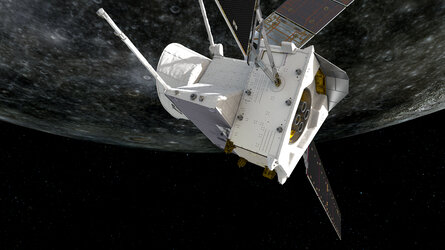Accept all cookies Accept only essential cookies See our Cookie Notice

About ESA
The European Space Agency (ESA) is Europe’s gateway to space. Its mission is to shape the development of Europe’s space capability and ensure that investment in space continues to deliver benefits to the citizens of Europe and the world.
Highlights
ESA - United space in Europe
This is ESA ESA facts Member States & Cooperating States Funding Director General Top management For Member State Delegations European vision European Space Policy ESA & EU Space Councils Responsibility & Sustainability Annual Report Calendar of meetings Corporate newsEstablishments & sites
ESA Headquarters ESA ESTEC ESA ESOC ESA ESRIN ESA EAC ESA ESAC Europe's Spaceport ESA ESEC ESA ECSAT Brussels Office Washington OfficeWorking with ESA
Business with ESA ESA Commercialisation Gateway Law at ESA Careers Cyber resilience at ESA IT at ESA Newsroom Partnerships Merchandising Licence Education Open Space Innovation Platform Integrity and Reporting Administrative Tribunal Health and SafetyMore about ESA
History ESA Historical Archives Exhibitions Publications Art & Culture ESA Merchandise Kids Diversity ESA Brand Centre ESA ChampionsLatest
Space in Member States
Find out more about space activities in our 23 Member States, and understand how ESA works together with their national agencies, institutions and organisations.
Science & Exploration
Exploring our Solar System and unlocking the secrets of the Universe
Go to topicAstronauts
Missions
Juice Euclid Webb Solar Orbiter BepiColombo Gaia ExoMars Cheops Exoplanet missions More missionsActivities
International Space Station Orion service module Gateway Concordia Caves & Pangaea BenefitsLatest
Space Safety
Protecting life and infrastructure on Earth and in orbit
Go to topicAsteroids
Asteroids and Planetary Defence Asteroid danger explained Flyeye telescope: asteroid detection Hera mission: asteroid deflection Near-Earth Object Coordination CentreSpace junk
About space debris Space debris by the numbers Space Environment Report In space refuelling, refurbishing and removingSafety from space
Clean Space ecodesign Zero Debris Technologies Space for Earth Supporting Sustainable DevelopmentApplications
Using space to benefit citizens and meet future challenges on Earth
Go to topicObserving the Earth
Observing the Earth Future EO Copernicus Meteorology Space for our climate Satellite missionsCommercialisation
ESA Commercialisation Gateway Open Space Innovation Platform Business Incubation ESA Space SolutionsEnabling & Support
Making space accessible and developing the technologies for the future
Go to topicBuilding missions
Space Engineering and Technology Test centre Laboratories Concurrent Design Facility Preparing for the future Shaping the Future Discovery and Preparation Advanced Concepts TeamSpace transportation
Space Transportation Ariane Vega Space Rider Future space transportation Boost! Europe's Spaceport Launches from Europe's Spaceport from 2012Latest

BepiColombo's sixth Mercury flyby
Thank you for liking
You have already liked this page, you can only like it once!
On 8 January 2024, the ESA/JAXA BepiColombo mission will fly past planet Mercury for the sixth time, readying itself for entering orbit around the Solar System’s mysterious innermost planet in 2026. At 06:59 CET, it will fly just 295 km above the planet's surface.
After flying over Mercury's cold, dark night side, the spacecraft will pass over the north pole. Monitoring cameras (M-CAMs) 1 and 2 will peer down into craters cast in permanent shadow before getting nice views of the vast northern volcanic plains and Mercury's largest impact crater, called the Caloris Basin.
The other science instruments switched on during this flyby are the magnetometers MPO-MAG and MMO-MGF, the ISA accelerometer, the MGNS gamma-ray and neutron spectrometer, the MIXS imaging X-ray spectrometer, the MORE radiometer, the SERENA and MPPE particle analysers, the SIXS X-ray and particle spectrometer, the MDM dust monitor and the PWI instrument which detects electric fields, plasma waves and radio waves.
BepiColombo, a joint mission between the European Space Agency (ESA) and the Japan Aerospace Exploration Agency (JAXA), will be the second and most complex mission ever to orbit Mercury. It comprises two science orbiters: ESA’s Mercury Planetary Orbiter and JAXA’s Mercury Magnetospheric Orbiter. While on their way to Mercury, the two orbiters are both attached to the Mercury Transfer Module.
[Image description: Infographic explaining BepiColombo’s sixth flyby of Mercury. In the centre of the graphic we see the spacecraft flying past the planet. On the left we see the inner Solar System in perspective, with the positions of Mercury, Venus and Earth indicated. On the right we see which of BepiColombo’s instruments will be activated during the flyby.]
-
CREDIT
ESA -
ACKNOWLEDGEMENTS
ATG Europe -
LICENCE
CC BY-SA 3.0 IGO or ESA Standard Licence
(content can be used under either licence)

BepiColombo Mercury flyby

BepiColombo Mercury flyby

Best images from BepiColombo's sixth Mercury flyby

Bepi, Mio and MTM's third Mercury flyby















 Germany
Germany
 Austria
Austria
 Belgium
Belgium
 Denmark
Denmark
 Spain
Spain
 Estonia
Estonia
 Finland
Finland
 France
France
 Greece
Greece
 Hungary
Hungary
 Ireland
Ireland
 Italy
Italy
 Luxembourg
Luxembourg
 Norway
Norway
 The Netherlands
The Netherlands
 Poland
Poland
 Portugal
Portugal
 Czechia
Czechia
 Romania
Romania
 United Kingdom
United Kingdom
 Slovenia
Slovenia
 Sweden
Sweden
 Switzerland
Switzerland
























